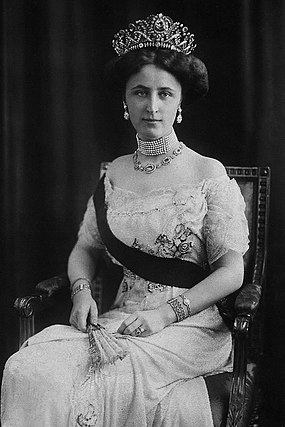by Scott Mehl © Unofficial Royalty 2017
Grand Duchy of Saxe-Weimar-Eisenach: The Duchy of Saxe-Weimar-Eisenach was created in 1809 when the Duchy of Saxe-Eisenach and the Duchy of Saxe-Weimar merged. The Congress of Vienna elevated Saxe-Weimar-Eisenach to a Grand Duchy in 1815. As the German Empire was crumbling at the end of World War I, Wilhelm Ernst, the last Grand Duke of Saxe-Weimar-Eisenach was forced to abdicate on November 9, 1918. He was stripped of his throne and his properties and forced into exile. With his family, he took up residence at Schloss Heinrichau, the family’s estate in Heinrichau, Silesia, now Henryków, Poland. Today the territory that encompassed the Grand Duchy of Saxe-Weimar-Eisenach is located in the German state of Thuringia.
********************

Wilhelm Ernst, Grand Duke of Saxe-Weimar-Eisenach source: Wikipedia
Wilhelm Ernst was the last Grand Duke of Saxe-Weimar-Eisenach. He was born Prince Wilhelm Ernst Karl Alexander Friedrich Heinrich Bernhard Albert Georg Hermann on June 10, 1876, in Weimar, Grand Duchy of Saxe-Weimar-Eisenach, now in the German state of Thuringia, the son of Karl August, Hereditary Grand Duke of Saxe-Weimar-Eisenach and Princess Pauline of Saxe-Weimar-Eisenach. Wilhelm Ernst had one younger brother:
- Prince Bernhard (1878-1900) – unmarried
Wilhelm Ernst became heir to his grandfather, Karl Alexander, Grand Duke of Saxe-Weimar-Eisenach, in 1894 when his father died. He received a private education and military training and served in the Prussian army. He became Grand Duke upon his grandfather’s death on January 5, 1901.

Caroline Reuss of Greiz. source: Wikipedia
Wilhelm Ernst married Princess Caroline Reuss of Greiz on April 30, 1903, in Bückeburg, Principality of Reuss-Greiz, now in the German state of Lower Saxony. She was the daughter of Heinrich XXII, 5th Prince Reuss of Greiz and Princess Ida of Schaumburg-Lippe. They had no children, and Caroline died less than two years later.

Feodora of Saxe-Meiningen. source: Wikipedia
Wilhelm Ernst remarried on January 21, 1910, in Meiningen, Duchy of Saxe-Meiningen, now in the German state of Thuringia, to Princess Feodora of Saxe-Meiningen. She was the daughter of Prince Friedrich Johann of Saxe-Meiningen and Countess Adelheid of Lippe-Biesterfeld. Wilhelm Ernst and Feodora had four children:
- Princess Sophie Luise (1911-1988) – married Friedrich Günther, Prince of Schwarzburg (divorced), no issue
- Karl August, Hereditary Grand Duke (1912-1988) – married Baroness Elisabeth of Wangenheim-Winterstein, had issue
- Prince Bernhard (1917-1986) – married Felicitas of Salm-Horstmar (divorced)
- Prince Georg (1921-2011) – married Gisela Jänisch in 1953, renouncing his rights and taking the name Jörg Brena, had issue
As Grand Duke, Wilhelm Ernst worked to promote the arts and culture. He established the new town center in Weimar, rebuilt the University of Jena, and several of the town’s theaters. Despite these efforts, the Grand Duke was not very popular with the people of the Grand Duchy or with many others throughout Europe. He was especially unpopular in the Netherlands, where the people feared he could ascend to the Dutch throne.

Queen Wilhelmina of the Netherlands. source: Wikipedia
From 1897 until 1909, Wilhelm Ernst was the heir presumptive to the Dutch throne. King Willem III of the Netherlands died in 1890, leaving the throne to his ten-year-old daughter Wilhelmina. As a grandson of Princess Sophie of the Netherlands, the younger sister of King Willem III, Wilhelm Ernst was the next person in the line of succession. This caused great panic in the Netherlands, where the people feared German influence or the potential of being annexed by Germany. Several attempts were made to change the succession, or limit Wilhelm Ernst to holding only one throne should he succeed in the Netherlands. The succession crisis was lessened in 1909 when Wilhelmina gave birth to her daughter, the future Queen Juliana. Some years later, in 1922, the Dutch constitution was amended to limit the succession to the descendants of Queen Wilhelmina, thus eliminating the Saxe-Weimar-Eisenach family from any claim to the throne.
As the German Empire was crumbling, Wilhelm Ernst was forced to abdicate on November 9, 1918. He was stripped of his throne and his properties and forced into exile. With his family, he took up residence at Schloss Heinrichau, the family’s estate in Heinrichau, Silesia, now Henryków, Poland. He died there less than five years later, on April 24, 1923, and is buried in the park at Schloss Heinrichau.
This article is the intellectual property of Unofficial Royalty and is NOT TO BE COPIED, EDITED, OR POSTED IN ANY FORM ON ANOTHER WEBSITE under any circumstances. It is permissible to use a link that directs to Unofficial Royalty.
Saxe-Weimar-Eisenach Resources at Unofficial Royalty
